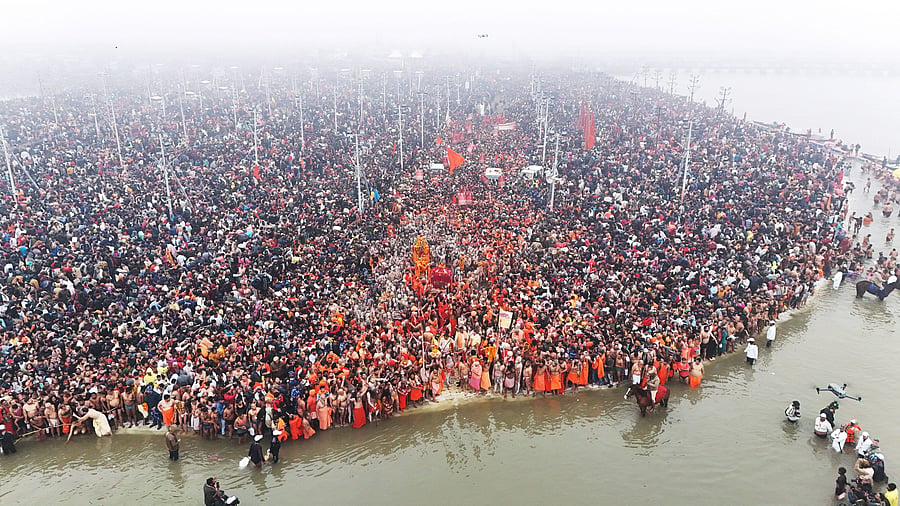
Flower petals being showered on devotees during the first 'Amrit Snan' at the Mahakumbh on Makar Sankranti festival, at Sangam in Prayagraj, Tuesday, Jan. 14, 2025.
Credit: PTI Photo
The much-awaited Maha Kumbh, which comes around once every 144 years, commenced on January 13 and will continue well into the next month, coming to an end on February 26.
As the world's largest gathering commenced, the first Amrit Snan, which was formerly known as Shai Snan, fell on the auspicious occasion of Makar Sankranti and saw over 3.5 crore devotees take the holy dip at the Triveni Sangam in Prayagraj.
This marked the first of the holy dips taken by Naga sadhus and was followed by hundreds of thousands of devotees.
Notably, it also marked the first time that non-Urdu words were used for these rituals.
Let's learn more about Shah Snan and why was its name recently changed to Amrit Snan.
What is 'Shahi Snan?'
The confluence of Ganga, Yamuna and the mythical Saraswati is known as the Triveni Sangam.
It is said that taking a dip in these holy waters any time during the Kumbh washes away your sins.
However, bathing at the Triveni Sangam during the Shahi Snan is believed to elevate piousness and bring forth a multitude of spiritual benefits.
Kumbh is celebrated at one of the four places where amrit, or the nectar of immortality, was spilled after Samudra Manthan, or the churning of the ocean, as per Hindu mythology.
Why did 'Shahi Snan' become 'Amrit Snan'?
While Shahi Snan has historically been the term used for the ritual, that changed recently under the Yogi Adityanath-led administration, with the renaming being effected to honour Hindu religious beliefs.
The Urdu word Shahi literally translates to 'royal', and with sadhus being the so-called 'royalty' of the Kumbh, Shahi Snan takes up the meaning of 'royal bath'.
The origins of the word 'Shahi' can be traced back to Persia and research suggests that it made its way into the Indian subcontinent through the influence of the Mughals.
On the other hand, the word 'Amrit' has its roots in Sanskrit, and literally translates to 'immortality'. It holds a deep significance in Hindu mythology and is associated with divinity and piousness.
Akhil Bharatiya Akhara Parishad (ABAP) president Mahant Ravindra Puri told PTI that terms like 'Shahi Snan' and 'Peshwai', which have been associated with the Kumbh Mela, have now been changed to 'Amrit Snan' and 'Chhavni Pravesh', respectively.
Mahant Puri, also the president of the Mansa Devi Temple Trust in Haridwar said, "All of us speak words in Hindi and Urdu. It cannot happen that we do not speak any Urdu word."
"But we thought that when it comes to our Gods, we should make efforts to have a name in Sanskrit language or have a 'Sanatani' name. Our intention is not to make it as Hindus versus Muslims," he added.
Significance of 'Amrit Snan'
Acharya Swami Avdheshanand Giri Maharaj, the Peethadheeshwar of Juna Akhara, explained the concept of Amrit Snan and stated that the event occurs when Jupiter enters Taurus, and the Sun and Moon align in Capricorn.
Seers call this alignment 'Amrit Yog', which occurs every once 12 years. However, he did say that changing the name does not diminish the significance.
